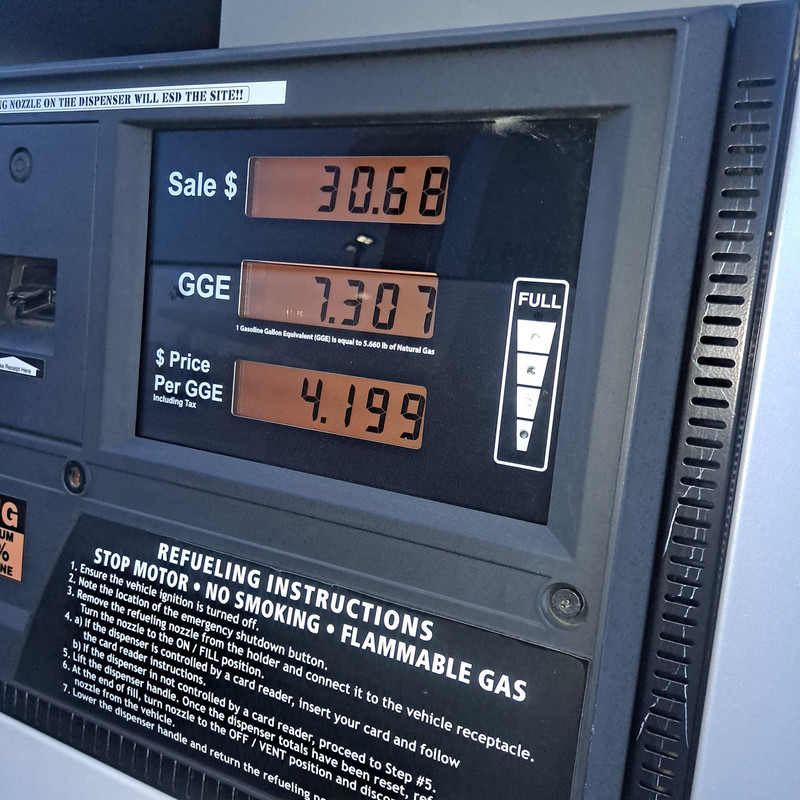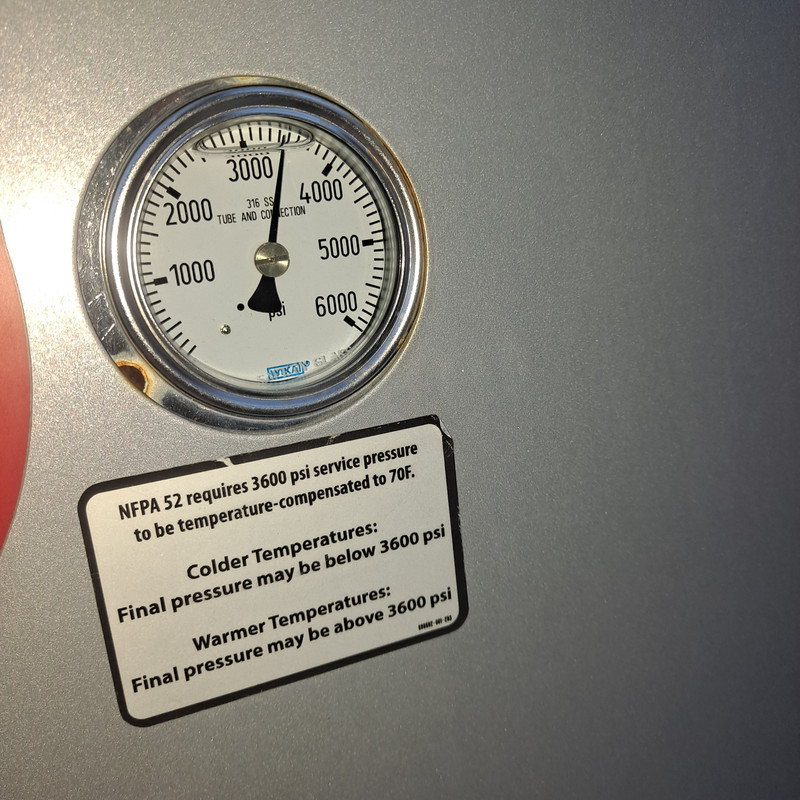Topic: Dual fuel Chevy Express weirdness
(Detail with answers here, edited question in post #6), more information in another post.
Original thesis:
GM Express, CNG: range, + question on fuel gauge for multiple tanks:
BLUF (Bottom Line Up Front):
1. what is the expected range if the vehicle has only two CNG tanks in the rear?,
I found the dual-fuel Supplement! Amazing what you can find when you open up things that shouldn't have anything in them. .
Answer: in this configuration, it's got a10.2 gge CNG capacity between the two rear tanks. In a dedicated CNG only configuration, it could have had another, large tank where the gasoline tank was (yes, was), and
2. Does the fuel gauge read sequentially with regard to available volume?
Answer: yes; kakarot is correct, with a dual-fuel configuration when it switches between fuels, as far as I can tell. Apparently the CNG is a single connected total volume for the two rear tanks. I still don't know why the gauge changed.
These questions are specific to the CNG fuel system. I've included more background information because: unusual characteristics.
And:
3. Should I leave the gasoline tank and use the vehicle as a camel for Lemons races?
Answer: Definitely NO. I dropped the tank, and the area around the pump opening was soft and crunchy from rust. The fuel that drained from the lines looked like urine.
CNG fuel vehicle:
Running out of fuel = getting towed to the pump. Nobody is coming with a tank for you. Nobody.
Background:
2001 Express 3500 extended passenger van, originally configured as a dual fuel van (gasoline and CNG), but had the gasoline deleted on the build sheet, so it wound up as CNG only. It has two CNG tanks in the rear (which interfere with me putting on a commercially available hitch receiver, dammit; it'll have to be custom).
This is a new-to-me van; I just bought it from a Mass. agency. I drove it from near Boston to Philly area, stopping at every CNG station which I could access on the way. It was _not_ a direct route.
Using the fuel gauge as a guide (because no owner's manual), the range appeared to be about 120+ highway miles before empty; for the trip from Boston to Philly this wasn't a problem.
Around town, however, a 100 mile range is ... inconvenient.
Apparently the van _could_ have had another _large_ tank midship, and there was a possibility of a fourth, mounted inside and upright in a rear corner; but this has only the two CNG tanks.
With the original configuration, gasoline was an option as the second fuel; apparently there could have been a second fuel rail mounted on the engine, and presumably: a fuel pump and other associated equipment for the remainder of a gasoline fuel system.
The build sheet has a gasoline delete code. I don't have that in front of me right now; I'll update this post later tonight. But I don't think it controls the answer to the questions.
I haven't yet pulled the dog box to look at the top of the engine to see if the 'gasoline delete' resulted in the factory _not_ installing the second rail onto the engine for a gasoline system.
But the van _does_ have a normal midship gasoline tank. I don't know why. So the 'gasoline delete' code doesn't remove all gasoline components from the vehicle.
Also, a button in the dash(!?!), presumably for a van which actually had the gasoline system installed to do the fuel switch to/from CNG.
So here's the weird part:
I was trying to see what the gauge would read when driven around town. I normally track fuel mileage in every vehicle I drive- mine, or not.
I planned a trip to run some errands, and wind up at the closest CNG pump at around 105 miles. When on the highway trip, 120+ miles seemed a good, safe interval; and the gauge showed a reasonable amount of fuel remaining when I got to the pump.
But during the recent trip, at 105 miles I was getting nervous looking at the fuel gauge. It was reading WAY too near empty for comfort.
I'm driving, and keeping an eye on the gauge, and I'm at about 106.3 miles on the odometer, and the needle almost on the red mark, when the I noticed the gauge now reads around a half tank.
There was no sputtering or stumbling from the engine. The van ran fine to the pump, at about 107.4 miles. It took about 8.7 gge (gasoline gallon equivalent); it had taken only a little less than that on the ~120 mile segment of the trip from Boston.
Each fill is different; the fill is based on pressure, and the amount is affected by the temperature as well as the pressure of the pump. So I do not consider the fuel gauge an absolute guarantee of driving range - not even close.
Check me, please:
What I'm thinking is the system is set up to run off one tank, and to open a valve when that tank runs down to a pressure low enough for the second tank to be needed; then the remaining CNG from both tanks is available; hence the change in fuel gauge.
But I don't know that.
Perhaps enough parts of the dual fuel system remain, that when the CNG tank ran low enough, the gauge from the gasoline tank showed the amount in the gasoline tank, so a driver could know when there were no more options before a needed fueling.
But I don't know that, either.
I've searched online for dual fuel tank questions, and there are many.
I've found threads related to Ford dual tanks, and the differences between some of those and GM systems.
My first thought is the CNG system would _not_ be integrated with the gasoline system, where the gauge would read first one fuel, and then the other, at least not without two complete systems installed, and a driver pushing the 'Gasoline' button on the dash to do a switch over.
I see the GM gasoline and diesel dual tank systems run off the front tank, and there's a low-pressure pump which is activated to move fuel from the rear tank to the front tank. And senders and associated modules to make the system function (and these do not always work).
But the postings seem to indicate the gauge reads the total fuel all the time, and not: first one tank and then the other, because a control module is supposed to balance the tanks on an ongoing basis.
I could easily conceive the tanks would have a safety system where if one tank ruptured the others would shut off; that makes perfect sense to me.
And that the normal operation of driving would _not_ trigger a shut off of sequential tanks, but a rapid decompression - like in a rupture - would.
I don't have a problem remembering whether the gauge changed reading (from almost empty to half remaining) - at least not yet ;-)
I'm curious if anyone has any experience or knowledge with such a system.
As an aside, the gasoline tank does have gasoline in it - of an indeterminate age, grade, and condition. I'm guessing someone either ran it out of CNG and panicked (hoping to avoid calling their manager to be towed to the pump), or perhaps wasn't convinced the 'gasoline deleted' was actually complete because, y'know, "gasoline tank"; regardless: the seller (Comm. of Mass.) was explicit - this was sold as a CNG ONLY vehicle.
Additional steps I'll take in the future include:
1. unplugging any electrical connectors to the gasoline tank, and
2. running it to almost empty again, but this time parking near the pump and just letting it run to see what the fuel gauge will do; but if a nominal range on the CNG system would be about twice what I expect from the one tank, that'd be burning a lot of CNG, and take about the equivalent of 100 miles of running time, but a lot longer because of idling.
I also have CNG Honda Civic, and I fill that with at most 7.? gge; that gets around a 200 mile range, but that's a small car and a 4-cylinder engine. The tanks look close to the same size, but I could be way off. I can't imagine if a Civic has a ~7 gge tank, that a GM van would be configured with _two_ which total out at around 9 gge.
I'd expect a full size V-8 van to still be configured to get about 200 miles on its primary fuel before needing to be filled.
Thoughts?


